| |
|
DOING IT BETTER
The 'clonal effect' in Election 2008
By Natasha Josefowitz, Ph.D.
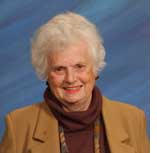 LA JOLLA, California—We have a choice today to exercise our prejudices—conscious or unconscious. We can use our racism if we can’t picture a bi-racial man in the Oval Office, we can tap into our sexism if we can’t see a woman as Commander in Chief or we can exercise our ageism if we feel anyone in their seventies is too old to be President. LA JOLLA, California—We have a choice today to exercise our prejudices—conscious or unconscious. We can use our racism if we can’t picture a bi-racial man in the Oval Office, we can tap into our sexism if we can’t see a woman as Commander in Chief or we can exercise our ageism if we feel anyone in their seventies is too old to be President.
It all has to do with the “clonal effect,” a term I coined in a Management Review article I wrote in September 1979. Then I used it to describe the problem of male-dominated organizations in hiring and promoting women. The clonal effect has to do with familiarity. We choose friends and colleagues, hire and promote people we are comfortable with—and who are these people? People most like ourselves. Our comfort level is predicated on who is predictable in terms of behavior and value systems. Note that even in kindergarten, little boys prefer other boys to play with as little girls prefer girls.
Go to a high school cafeteria and you will see the same thing—both genders segregate themselves A cocktail party has some of the same phenomena, men, drinks in hand standing in a huddle, women, sitting on a sofa, talking. Of course, not always and not exclusively—I’m talking tendencies.
People like to identify themselves with candidates who represent them and who can speak not only for them, but speak the same language. Hence, the black voters for Senator Obama, the older white women vote for Senator Clinton, and as the baby boomers are advancing in age, they don’t see a problem with a President in his seventies, some younger people do—their grandparents are that age.
The interesting side of all this is the unconscious part: What we are unaware of, what we respond to as knee-jerk reactions. Any statement that starts with “I just can’t see (name a candidate) as President” can often be a reaction to an unconscious trigger, unless it is a thought-through, rational argument—which it is often not.
As you read this, stop and examine who you congregate most comfortably with; with whom do you choose to sit, go out, work? This will provide you with information about your own unconscious preferences.
For me, if my doctor is older, do I wonder whether he still reads the latest research or is out-of-date, and if my doctor is young, do I wonder whether he’s seen enough cases like mine or whether he’s experienced.
Then there is the whole gamut of gender-role expectations—a woman firefighter is noticed more, as well as a male secretary. We may also feel discomfort visualizing a person of color where only whites have tread.
Some Jews may be uncomfortable with Muslims who may be uncomfortable with atheists who may be uncomfortable with Christians who may, to complete the circle, be uncomfortable with Jews.
Unless you get in touch with your own predispositions and role expectations, your decisions will be colored by feelings instead of stemming from rational thought.
So look around you, who are your friends, who are you most comfortable with, who is familiar and therefore predictable, and on the opposite side of the spectrum, who puts you on your guard, gets your defenses up, or worse still, who do you patronize and not take seriously: the middle-aged white woman, the young black man or the old white guy?
For the first time in the history of our country, we are given an opportunity to look at our prejudices in the national political arena and not act on them. May the best candidate for the job win!

THE HISTORY MAN
Ongoing hostility to Israel in British media
By Lloyd Levy
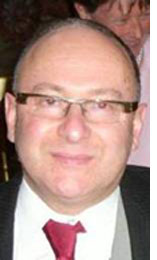 LONDON—To give you some flavour of the hostility to Israel in much of the British media, I wish to draw your attention to an article in the Daily Telegraph on Friday, March 21. This was in the Film Review section, of a newspaper that generally is considered to be quite sympathetic to Israel. The author was someone called Sukhdev Sandhu, and of all the films on release in UK, he choses to talk about “Under the Bombs," made in Lebanon, and I very much doubt likely to be on general release in UK. LONDON—To give you some flavour of the hostility to Israel in much of the British media, I wish to draw your attention to an article in the Daily Telegraph on Friday, March 21. This was in the Film Review section, of a newspaper that generally is considered to be quite sympathetic to Israel. The author was someone called Sukhdev Sandhu, and of all the films on release in UK, he choses to talk about “Under the Bombs," made in Lebanon, and I very much doubt likely to be on general release in UK.
 Extracts from his article include- “(it) is about the 2006 Israeli invasion of Lebanon, a 33 day siege that left 1,189 men and women dead and created a million refugees.” Extracts from his article include- “(it) is about the 2006 Israeli invasion of Lebanon, a 33 day siege that left 1,189 men and women dead and created a million refugees.”
- “the film highlights the extent of the misery wreaked on the Palestinian people by the Israeli forces.”
- - “I am unable to forget one character’s lament that even the sound of the wind is like that of bomber planes.”
All this vile and completely one sided anti-Israel hysteria, in the Film section of a respected national newspaper.
It is far from a one off circumstance. I read in Haaretz today, that the BBC has had to apologise for two “lies” that were put out on recent news reports. One newsreel purported to show the Israelis bulldozing down a house, and another report that the UN Secretary General had accused Israel of attacking civilians. Both these reports were found to be completely false.
The cumulative effect of this continual barrage of attacks, on Israel’s long term security and on the morale of British Jewry, is incalculable.


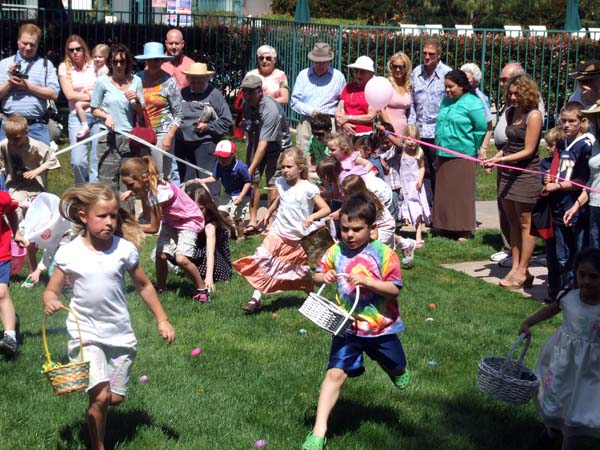
THE JEWISH CITIZEN 'A Jewish Story Everywhere'
The real importance of the Easter bunny
By Donald H. Harrison
 OCEANSIDE, California—Visiting the senior village known as Ocean Hills Country Club, where residents hosted a petting zoo and Easter egg hunt for grandchildren and great-grandchildren, I kept asking myself, “all this is very nice for the children, but what does it have to do with the story of Easter?” After some research over the weekend, I decided that the answers were “nothing” and “everything” and it gave me some insight into the movement that calls itself “Messianic Judaism.” OCEANSIDE, California—Visiting the senior village known as Ocean Hills Country Club, where residents hosted a petting zoo and Easter egg hunt for grandchildren and great-grandchildren, I kept asking myself, “all this is very nice for the children, but what does it have to do with the story of Easter?” After some research over the weekend, I decided that the answers were “nothing” and “everything” and it gave me some insight into the movement that calls itself “Messianic Judaism.”
My father-in-law Sam Zeiden lives at the country club, which enjoys a large population of both Jews and Christians and possibly members of other faiths as well. Just as we always wanted our children to learn about other religions when they were growing up, so too are we now glad for opportunities for grandchildren Shor, 6, and Sky, 1, to be exposed to the larger world in which we live.
Three lawns near the swimming pool complex of the country club were seeded with plastic eggs and surrounded with ribbon barriers. One lawn was for children 4 and under, another for children 5-8, and the third for children over 8. On a signal, children could go under, over, or through the barrier, then gather up as many eggs as possible in their baskets or bags. Inside the eggs they would find either tiny prizes, or a piece of paper with a number corresponding to a larger prize.
When the signal was given, the kids swarmed over the lawns, gathering up every bit of sustenance. If these had been locusts, they’d have been a biblical plague, but as they were children, they were a blessing. Within a few short moments, everything was consumed. Our grandchildren (Sky with a little help from grandma) came away from the competition with numerous little toys that they had “won.” The excitement was palpable.
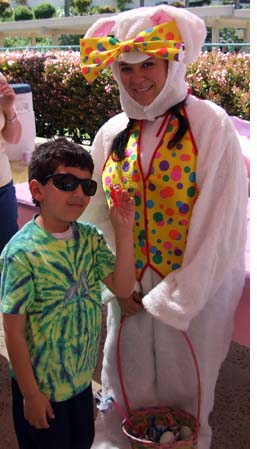 Nearby a young woman in a bunny costume—the Easter variety, not the Playboy kind—posed with the children, adding to the store of memories. Nearby a young woman in a bunny costume—the Easter variety, not the Playboy kind—posed with the children, adding to the store of memories.
Remembering the controversy over the Mel Gibson film, The Passion of the Christ, I tried to discern the connection between the faith story of the crucifixion and resurrection of Jesus and the tale of the Easter bunny. In Christian belief, three days after he was crucified, Jesus was resurrected, verifying claims that he was divine.
Eggs symbolize the renewal of life. During our own Passover seders, we Jews typically serve eggs; Christians, too, utilize the symbol. And the bunny? Well, rabbits or hares, as the case may be, are renowned for their ability to reproduce, so both eggs and bunnies are suggestive of reproduction. Reproduction and resurrection are different concepts but they both suggest the continuation of life.
But this connection, however logical it may be, does not go to the heart of the matter.
Wikipedia offers an interesting historical explanation, suggesting that the celebration of an egg-laying bunny or hare was associated with the springtime observance of the vernal
Equinox among Northern European pagans. The People’ Media Company asserts that this ritual was incorporated deliberately into Christianity as a way of winning the affections of the populace. There is a suggestion in About.com that early Christians understood people would accept Jesus if they could do so without giving up their beloved rituals. Over time, the meaning of the rituals were transformed.
In a similar vein, some scholars, though not all, believe that Mexico’s esteemed Virgin of Guadalupe was a substitute figure for the earlier Aztec goddess of fertility, Tonantzin. In this manifestation of Mary, the mother of Jesus appears to have the dark skin of a Mexican mestizo, making her a more accessible figure for indigenous people to worship than the Mary of porcelain-white skin depicted in European paintings.
So what does this have to do with “Messianic Judaism” and its related movement “Jews for Jesus?” There is a belief among some Christians that other peoples are more interested in style than in substance. There is a belief that if they give us Jews our style (tallisim, kippot, Hebrew prayers), they could transform it into their substance (belief in Jesus as the divine child of God.)
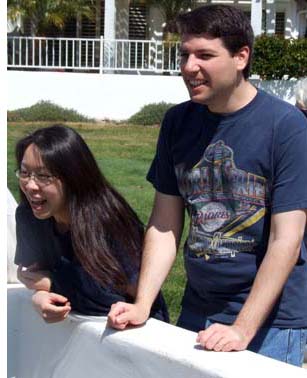 The bunny of Easter and the Santa of Christmas, seen in this light, are not so much distractions from Christianity as they are salespeople—especially to the world’s most loyal customers, children. The bunny of Easter and the Santa of Christmas, seen in this light, are not so much distractions from Christianity as they are salespeople—especially to the world’s most loyal customers, children.
In talking to people who have gone through the process of converting to Judaism from Christianity, I learned that often it was not difficult for them to exchange the theology of their religion for ours. What was difficult for them—and these were adults—was giving up the pleasant associations of Easter and Christmas, the bunny and Santa. Associated with these symbols were powerful memories of family get-togethers and happy occasions. For Shor's and Sky, such a memory might be Uncle David and Aunt Hui-Wen Harrison, pictured at right, cheering the children on during the egg hunt.
Understanding the power of these memories, some Jews counsel keeping the children away from the festivals and celebrations of other people, so as not to cause within them possible conflict. I disagree strongly with this approach. Why make these ceremonies even more attractive by imbuing them with the quality of "forbidden fruit?"
We Jews have just finished our Purim festival, in which, one hopes, our little children added greatly to their memory banks. Soon, we will again celebrate Passover, in which we have the wonderful ceremonies of the child asking the four questions, opening the door for Elijah, and the searching for the afikomen. Later in the year, of course, we will have Chanukah, when we fry latkes, spin dreidels, give gelt and open presents. All these ceremonies are not childish distractions from the important religious business at hand. They are part of the process of building deep and abiding loyalty to our Jewish culture.
As important as this “style” is, it is of paramount importance that our children also learn the substance. I am delighted that Shor and Sky attend Soille San Diego Hebrew Day School, where Shor is a first grader and Sky is in the nursery/ preschool. Shor loves to hear and read the stories of the Torah and can discuss them with great knowledge, and surprising insight. Given that Sky, at age 1, already wants to do everything that his big brother does, I won't be surprised if he too learns to love the Torah and regard it as his "tree of life."
Memories and knowledge, together, build a child so secure in his or her Judaism that there is no reason to be fearful of that child encountering and enjoying the traditions and customs of other peoples.


REFLECTIONS
Bella Family: The Revolt of the Cousins
By Sheila Orysiek
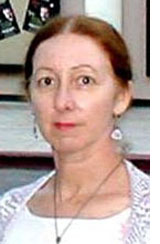 SAN DIEGO—The descendants of Great Grandmother Bella, and the people who married them, had formed a family group: the Bella Family Circle. In addition to the monthly meetings, membership ($1.00 a month per adult) included the large (approximately 75 people) Passover Seder, the Annual Picnic, Trip to the Shore and other events and incidental privileges. SAN DIEGO—The descendants of Great Grandmother Bella, and the people who married them, had formed a family group: the Bella Family Circle. In addition to the monthly meetings, membership ($1.00 a month per adult) included the large (approximately 75 people) Passover Seder, the Annual Picnic, Trip to the Shore and other events and incidental privileges.
The presidency was always held by the oldest of my Great Grandmother’s Sons. Uncle Israel was the undisputed family patriarch, a most benevolent, but nevertheless the ultimate authority. He was the second oldest of the brothers, Uncle Sam (blessings on his name) had already gone on to higher glory. The meetings took place in the members’ homes and they were orderly - under the firm parliamentary leadership of Aunt Bessia. She had once been president of a synagogue sisterhood and we would not have been surprised if Robert’s Rules of Order had used her as a consultant. The rest of the officers were the senior Uncles with an occasional senior Aunt; except for Cousin Annie, Sunshine and Bulletin Chairman, committee of one.
Beneath this first layer of authority were the First Cousins – which included my father. Members of this group of Cousins at the time of the Revolt were in their late twenties or early thirties and they could see it would be many a year before the mantle of authority would fall on their shoulders. However, they weren’t really interested so much in assuming authority as having a good time.
The Bella Family Circle met on Sunday evenings to avoid driving on the Sabbath which was important to the religiously observant older generation. However, Sunday came before Monday when the younger members had to arise early to go to work. After much murmuring by the Cousins, the Seniors, in an effort to accommodate them, occasionally held meetings on Saturday evenings in the winter when the sun set early. However, on Saturday night the younger members wanted to stay out later, and have a bit more fun than having Aunt Bessia “calling for the question” or dividing “New Business” from “Old Business” or voting on which kosher restaurant would host the next Seder.
The problem was how to have a separate club – a Cousins Club - while at the same time avoiding any appearance of rejecting the patriarchs and matriarchs – their very own mothers and fathers – the people who had given them life, food, shelter and everything else, accompanied by strategic reminders of the aforesaid.
The Cousins went to great lengths to give assurances that the formation and participation in the Cousins Club would not replace their allegiance to the Bella Family Circle, but would be a mere adjunct, a devoted child, loyal, loving, and definitely secondary. However, it was hard to overcome the underlying message that the Cousins wanted to have fun, and weren’t finding in the presence of their parents.
Nonetheless, being young the Cousins girded up their loins and ventured out into the Brave New World of forming their own unit. The Cousins Club started off with bright eyes and high hopes; disavowing any need for the formalities of the Bella Family Circle such as officers or minutes. But, they soon were confronted with the necessity of making some decisions and therefore reluctantly elected a president, and in order to have some record of proceedings, some one to jot down those decisions - a recording secretary.
They wanted to have a bulletin mailed out announcing upcoming events which meant the appointment of a bulletin chairman, and to fund the mailing – an imposition of dues, and therefore a treasurer. To avoid chaos, meetings had to follow some sort of order (Robert’s again), so thus a parliamentarian. Cousin Rachel didn’t know anything about “motions” and “questions” so she was the perfect candidate. In a short time, the Cousins found themselves a mirror image of the senior component they were trying not to be.
Nevertheless, they vowed to keep the business part of the evening short (as long as no one argued over what constituted New Business versus Old Business) and spend most of the time having fun. The problem was – what does one do with approximately 25-30 people in a small house intent on having fun? One answer was Charades. They played vigorous games of Charades, that is, until the incident of Cousin Selma’s birthday. Someone came up with the idea of a prank in which everyone would be made aware ahead of time what Cousin Selma was trying to portray in Charades, and they all would purposely guess at anything BUT that.
On the fateful night, in honor of her birthday, Cousin Selma was asked to go first. When she pulled her slip of paper out of a bowl with the instructions of what to portray, she didn’t know that every slip of paper said the same thing: “March of the Wooden Soldiers.”
So, with great enthusiasm she marched, stamped, tramped, clomped and stomped around (trying to look wooden all the while) as the Cousins shouted out every synonym except “march” which caused Cousin Selma to stamp around with even more vigor and determination, finally exhausting herself. At the end they all admitted it was a birthday prank and dissolved in laughter – except for Cousin Selma who laughed a bit less as she replayed in her mind how she must have looked marching around to no avail. That pretty much ended “Charades” as no one quite trusted the game again.
So, how else to “have fun?” One of the intentions of the Cousins was to stay out later than the Bella Family Circle meetings usually did, but when confronted with the reality of having to get home to make sure the babysitter got home at a decent hour, the joys of staying out late lost some of its luster. At least at the BFC meetings children came along and fell asleep in a bedroom - or on grandma’s lap.
There was another reality. The reality of one’s mother or father calling the next day to ask what the Cousin’s Club had done by way of having fun, with the underlying message of “So you think being with your mother/father isn’t fun?” The Cousins found themselves spending a good deal of time reassuring their parents how very much fun their parents were. So much so that in fact the Cousin’s Club wasn’t nearly as much fun as the Bella Family Circle, which left everyone wondering why the Cousin’s Club existed.
As I recall, the Revolt of the Cousins only lasted six months – there’s a limit to how much fun one can have playing pranks with Charades and then trying to explain to one’s mother the next morning over the phone why Cousin Selma’s mother is no longer speaking to several other Aunts and Uncles.




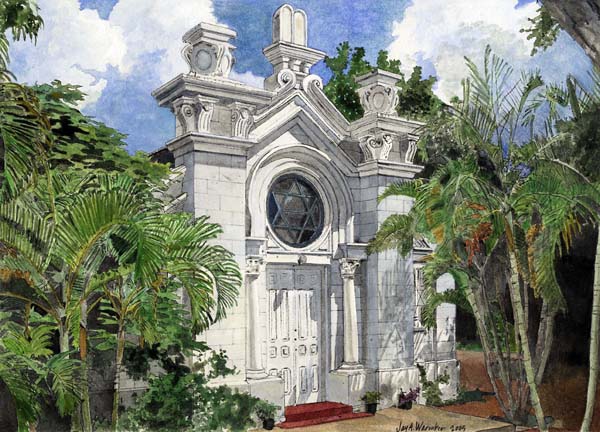
Restoring a synagogue in Mozambique
Editor's note: This article originally appeared in the quarterly newsletter of Kulanu (www.kulanu.or), a grassroots organization serving dispersed Jewish populations.
By Jay A. Waronker
 MAPUTO, MOZAMBIQUE—Set within a central site in Mozambique’s capital city, Maputo’s synagogue is a beautiful little structure built in the Portuguese Baroque-revival style. The Jewish house of prayer, the only ever built in this southeastern African nation, was consecrated in 1926 on property procured by the congregation’s executive board five years prior. Mozambique was then a Portuguese state and its tree-lined tropical capital was known as Lourenco Marques. How this attractive white-washed synagogue came to be realized within this outpost of the Diaspora was something I set out to discover as a recent Fulbright scholar on sub-Sahara African Jewish architecture. MAPUTO, MOZAMBIQUE—Set within a central site in Mozambique’s capital city, Maputo’s synagogue is a beautiful little structure built in the Portuguese Baroque-revival style. The Jewish house of prayer, the only ever built in this southeastern African nation, was consecrated in 1926 on property procured by the congregation’s executive board five years prior. Mozambique was then a Portuguese state and its tree-lined tropical capital was known as Lourenco Marques. How this attractive white-washed synagogue came to be realized within this outpost of the Diaspora was something I set out to discover as a recent Fulbright scholar on sub-Sahara African Jewish architecture.
The Jewish Community – The Early Years
At the time of the synagogue’s consecration, there were some 30 Jews in Lourenco Marques from Portugal, Spain, the Netherlands, Russia, Ukraine, the Baltic States, and various Eastern European nations. They had settled in this enclave beginning in the late 19th century for a variety of professional and personal reasons. As immigrants from the width and breadth of Europe speaking many languages, originating from both the Sephardic and Ashkenazi communities, coming from a range of social and educational backgrounds, and taking on a variety of activities and professions once in Mozambique, they were a diverse, even disparate, group.
Although the synagogue dates from 1926, its congregation was founded in 1899 by Reverend Dr. Joseph Herman Hertz on his arrival in Lourenco Marques from Johannesburg. Dr. Hertz had been exiled by President Kruger’s South African Government on account of his pro-British positions.
Hertz briefly found haven in Mozambique’s capital before resettling in English-controlled Durban a week later, but his short stay in town produced lasting results. At his meeting with Maputo’s Jews, Dr. Hertz impressed the need to organize a community, procure space for a Jewish cemetery, find land for building a synagogue, and assist in Jewish education. Over a period of years and in stages, these goals came to be realized.
Steps to Building a Synagogue
During the early years of the 1920s, a Jewish cemetery was founded and a tiny chapel (now derelict) built on property granted by the municipality in central Lourenco Marques. About the same time an organization called the “Honen Dalim” was established. With officers elected and a general assembly selected, it set out to acquire a plot of land to build a synagogue and school as well as to maintain the cemetery.
From 1899 and lasting for a quarter of a century, the Jews of Lourenco Marques had no communal property for congregating. Services, whenever held, were led in private homes or temporarily in commercial property. By the early 1920s, it became clear to the community that a synagogue was needed. In September 1921, as a first step, a building site on Avendia General Botha (formerly Telegraph Avenue) was purchased. Next to come was the design and construction of the synagogue.
The architect of Maputo’s synagogue was the non-Jew Couto Martins of the Public Works, and Raimundo Moreira of Lourenco Marques served as the contractor. Neither gentleman had previous synagogue experience. It is not clear what guidance the synagogue’s board gave Mr. Martins nor why the building looks as it does. The building, grandly consecrated in 1926, cost about 1,500 libras and comfortably sat 80.
In the 1970s and 80s, after the anti-religion Marxist government took control of the synagogue and other houses of worship throughout Mozambique, Red Cross offices were housed here and the synagogue was used as a its warehouse.
The synagogue has a prime location in one of the nicest sections of Maputo and is today on valuable real-estate.Parking for the synagogue has always been on the street, so in its history vehicles have never infringed on the site. Within a short walk is the Museum of Natural History, and in the immediate vicinity are many shops, restaurants, businesses, hotels, low and high-rise residences, and government offices. Also nearby is the early twentieth century Geological Museum. This building has often been confused as a synagogue since it features a large window at its façade containing a Star of David.
In the mid-1990s, minor alterations were carried out. A wall was added along the street and painted steel gates with a blue Stars of David were installed. While functional, they do not complement the aesthetic of the synagogue. Today the gate is kept locked and the property manned by a team of guards supposedly on duty.
Maputo Synagogue is a Portuguese Baroque-revival building with its white-washed plaster walls, symmetry, liberal classical features, setbacks, swoops, angled walls, vertical projections, planar relief, pronounced shadow lines, and flanking towers. The structure is also notable for its incorporation of scrolls, profiled brackets, volutes, urns, medallions, and bold use of trim. The absolute emphasis on the façade in the theatrical, stage-set tradition is another distinct element of Baroque architecture.
From the front, the synagogue is fancy and flamboyant, making for a memorable approach and first impression. It is a relatively exuberant and striking building closely resembling earlier churches built in Portugal or at its former outposts.
Compared to the elaborate front, the sides and rear of the Maputo Synagogue are plain, even dull. Except for a base line and unadorned shallow pilasters interspaced with windows, these three elevations are featureless squat walls. Today the windows are protected by painted steel grilles with a Star of David pattern. These bars are clearly not original and were likely added in the 1990s.
Typical to many early 20th century buildings in Maputo, the gabled roofs of the synagogue are corrugated metal that are supported by a simple wood framing system whose members are exposed at the overhangs. Today the roof, partly rusted and with crude flashing, noticeably sags and is not altogether watertight.
A Restrained Interior
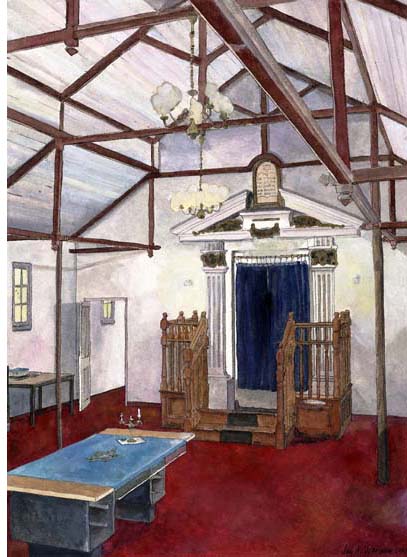 Unlike the elaborate front elevation of the synagogue, the interior is restrained. The pair of painted paneled wooden doors leads into a small foyer. Its only decoration is a shallow commandment-shaped panel affixed to the wall opposite the entry doors. Today it is blank, but it was once used for synagogue announcements. Unlike the elaborate front elevation of the synagogue, the interior is restrained. The pair of painted paneled wooden doors leads into a small foyer. Its only decoration is a shallow commandment-shaped panel affixed to the wall opposite the entry doors. Today it is blank, but it was once used for synagogue announcements.
From the foyer, the visitor is given a choice, to turn left or right, and pass into anterooms. These small mirrored spaces are identical except for service equipment. The sanctuary, 39’ (12m) x 25’ (7.5m), follows in plan. What is unconventional about walking into this room is that the view is not of the ark, which is the common focal point of synagogues, but of the synagogue’s rear wall. The original drawings for the design of the synagogue show entrances on the opposite wall, but the orientation of the site would have made entering from the far side impractical.
The interior of Maputo synagogue has a smooth concrete floor, now painted a vermillion red, and it appears to be original. It walls are masonry, loading bearing veneered in plaster that have been painted cool white. Today there are prominent cracks or fissures in areas of the walls. Although these clearly indicate settlement and structural concerns of the synagogue, the building appears stable and in adequate condition.
Narrow casement windows, set high off the floor, line the walls of the sanctuary. Four are along each of the side walls and two at the rear near the corners. These windows, swinging inward, are in poor condition with panes of glass cracked or missing and the wooden units deteriorated or rotted.
The synagogue’s sanctuary is a modified basilica plan, an arrangement first devised by the ancient Romans for secular purposes that in time came to be applied to many religious buildings. At its highest point, along the central ridge, the sanctuary is 20’-2” high and the side walls measure 10’-6” in height.
A high circular window with its Star of David pattern is centered on the sanctuary’s rear wall. Now in derelict condition, it matches the one at the synagogue’s front elevation. At one time it was also glazed with clear glass within the star pattern itself and translucent blue glass filing the perimeter. Over the years, sections of the glass were broken or vandalized (including a series of incidents in 1965) and wrongly replaced, so today none of the colored panes remain.
Lighting within the synagogue today is made up of four small brass chandeliers that hang from the posts and beams. They are in working order albeit tarnished and dirty. Not original to the building since early photographs indicate the synagogue had larger ball chandeliers featuring more arms, the current ones are nonetheless tasteful.
The Seizure and Reclaiming of the Synagogue
After the departure of the Portuguese in June 1975, and ensuing into the 1980s during years of civil war and the Marxist Frelimo government, organized religions were not tolerated in Mozambique. The Maputo Hebrew Congregation Synagogue was taken by the government when President Samora Machel nationalized all privately-owned buildings in 1976. The actual acquisition of the synagogue was not so much a physical seizure as commonly reported but more a default since, during these adverse times, most members of the Jewish community fled from Mozambique.
In the spring of 1975, the synagogue’s sefer Torahs had been sent to South Africa for safekeeping along with the keys to the building. For some years the structure was used for an array of inappropriate activities and functions, including a place reportedly for prostitution, and not properly maintained. Even once the Jewish community regained control of the synagogue, it allowed the building to be rented out as a kindergarten without any connection to the congregation. While the synagogue did survive these difficult years, its bimah, pulpit, furnishings, and many of its fittings were removed and lost.
The furniture found within the building today was put there after the synagogue was reclaimed by the Jewish community in 1989. The inventory is modest: one small plain wooden table, a small wooden bookshelf, and two steel desks. One desk currently serves as the shulchan. Draped with a blue cloth with a gold Star of David in the center, this makeshift surface is freestanding and, in the Sephardic tradition, centrally placed in the sanctuary.
The other furniture now in the synagogue is banks of theatre-like seating. Not original to the building, the 45 seats are stained wood, not all matching, in poor condition, in some cases missing seats, and of early 20th century vintage. Two sections are positioned against each of the side walls and five others are stacked haphazardly to the rear of the sanctuary. None are currently used and it is doubtful that any have been regularly sat on since the synagogue reopened in 1989.
The synagogue’s ark is centered on the northeastern wall of the sanctuary. Since it is Jewish custom to locate the ark on the wall closest to Jerusalem, the synagogue meets that liturgical arrangement. The sefer Torahs sent to South Africa for safekeeping during the civil war were never permanently returned. Today the opening is covered by navy blue velvet drapes hung on a wooden rod.
A couple of years back, the synagogue committee commissioned a local carpenter to fabricate a new pulpit, and paid him half the sum as a retainer. To this day, the work has never been completed nor has the money been refunded.
In the early 1990s, one of the sefer Torahs sent to South Africa in 1975 for safekeeping was returned once the synagogue had been reclaimed. It remained in the Maputo Hebrew Congregation Synagogue’s ark until 1997, when Chief Rabbi Cyril K. Harris of the Union of Orthodox Synagogues of South Africa authorized Rabbi Moshe Silberhaft, the spiritual leader of the southern African communities and of the African Jewish Congress, to return it to South Africa. Maputo’s Jews had violated conditions for keeping it, including the provision of a minyan. Since that time, the synagogue has been without a sefer Torah.
Maputo’s Jewish Community and Synagogue Today
Once the Maputo synagogue opened in 1926, the Jewish community remained stable for the balance of the decade and the 1930s. At that time, the Jewish population of South Africa slowed dramatically once the Aliens’ Act was enacted. This curtailed Jewish immigration, so Mozambique became a shelter for reluctant refugees. Some Jews who escaped Nazi occupied Europe traveled via Lisbon, it being one of the last neutral European ports, to the likewise neutral ports of Mozambique. Many of the new arrivals were destitute, however, since a Portuguese law prevented non-citizens from seeking employment or engaging in commerce. By 1942, due to World War II and immigration restrictions elsewhere, the Jewish population of Lourenco Marques reached its peak of some 500. Soon thereafter, men of military age and their families were granted visas to enter the Union in British South Africa presumably to enable them to join the army. This reduced the refugee community in Maputo, only to be followed, immediately after the end of the Second World War, by refugees leaving for neighboring Swaziland when work become available to them.
By the 1950s, the numbers of Jews living in the city had further decreased. In the 1960s, some Jewish refugees settled in Lourenco Marques briefly during the instability of the neighboring African independence movement. Nearly all left for South Africa or lands abroad.
At the time of national independence from Portugal in 1975 and the years of civil war that followed, a high percentage of Jews left Maputo. Previously small, the Jewish community diminished in size and stature. Following this dark period, the city never attracted many new Jews.
Although Maputo is now stable with an improving economy, the Jewish community numbers no more than 20 people. As a result, its synagogue is irregularly used and the building is not completely maintained. On a typical Sabbath, services are sometimes held on Friday evenings but never on Saturday. Rarely is there a minyan. While the size and vitality of the congregation will unlikely change, let there be hope that funding can be secured to restore the synagogue. May this architectural gem be enjoyed by its congregation and visitors for years to come.


SAN DIEGO JEWISH WORLD THE WEEK IN REVIEW
Carol Davis in Vista, California: You never can tell... or should you?
Donald H. Harrison in Rancho Santa Fe, California: Mom, 80, helped arrange surprise party for her 80-year-old son, the writer
Dov Burt Levy in Salem, Massachusetts: Issues in the wake of terror last forever
Janet Tiger in La Jolla, California: Sculptor Shirley Lichtman becomes subject of JCC art exhibit only a day after her death
Gidi Yahalom in Kibbutz Beit-Alfa, Israel: Pig's Testimony: Why Jews Don't Eat Pork
Judith Apter Klinghoffer in Cherry Hill, New Jersey: McCain's foreign policies score with Jews
Rabbi Baruch Lederman in San Diego: Harry S Truman: The American Cyrus
Rabbi Dow Marmur in Jerusalem: John McCain: A true friend of Israel
Sheila Orysiek in San Diego: The Four Big Questions; One Great Answer
Rabbi Leonard Rosenthal in San Diego: Purim riddle: Did Tanakh predict baseball?
Ira Sharkansky in Jerusalem: Palestinian-Israeli friction points range from cell phones to the right of return
Thursday, March 20, 2008 (Vol. 2, No. 69)
Carol Davis in San Diego: Music, dance numbers overcome tedious plot lines in Globe's Dancing in the Dark |
|

 —
—